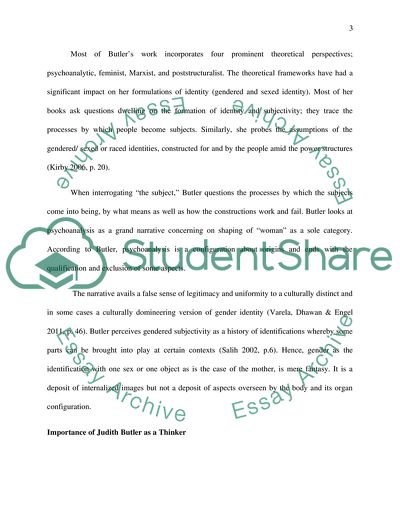Cite this document
(What does Judith Butler Mean by the Social Construction and Research Paper - 1, n.d.)
What does Judith Butler Mean by the Social Construction and Research Paper - 1. Retrieved from https://studentshare.org/gender-sexual-studies/1774512-what-does-judith-butler-mean-by-the-social-construction-and-performativity-of-both-sex-and-gender-illustrate-these-ideas-further-with-a-discussion-of-normative-and-queer-performances-of-gender-identity
What does Judith Butler Mean by the Social Construction and Research Paper - 1. Retrieved from https://studentshare.org/gender-sexual-studies/1774512-what-does-judith-butler-mean-by-the-social-construction-and-performativity-of-both-sex-and-gender-illustrate-these-ideas-further-with-a-discussion-of-normative-and-queer-performances-of-gender-identity
(What Does Judith Butler Mean by the Social Construction and Research Paper - 1)
What Does Judith Butler Mean by the Social Construction and Research Paper - 1. https://studentshare.org/gender-sexual-studies/1774512-what-does-judith-butler-mean-by-the-social-construction-and-performativity-of-both-sex-and-gender-illustrate-these-ideas-further-with-a-discussion-of-normative-and-queer-performances-of-gender-identity.
What Does Judith Butler Mean by the Social Construction and Research Paper - 1. https://studentshare.org/gender-sexual-studies/1774512-what-does-judith-butler-mean-by-the-social-construction-and-performativity-of-both-sex-and-gender-illustrate-these-ideas-further-with-a-discussion-of-normative-and-queer-performances-of-gender-identity.
“What Does Judith Butler Mean by the Social Construction and Research Paper - 1”, n.d. https://studentshare.org/gender-sexual-studies/1774512-what-does-judith-butler-mean-by-the-social-construction-and-performativity-of-both-sex-and-gender-illustrate-these-ideas-further-with-a-discussion-of-normative-and-queer-performances-of-gender-identity.


